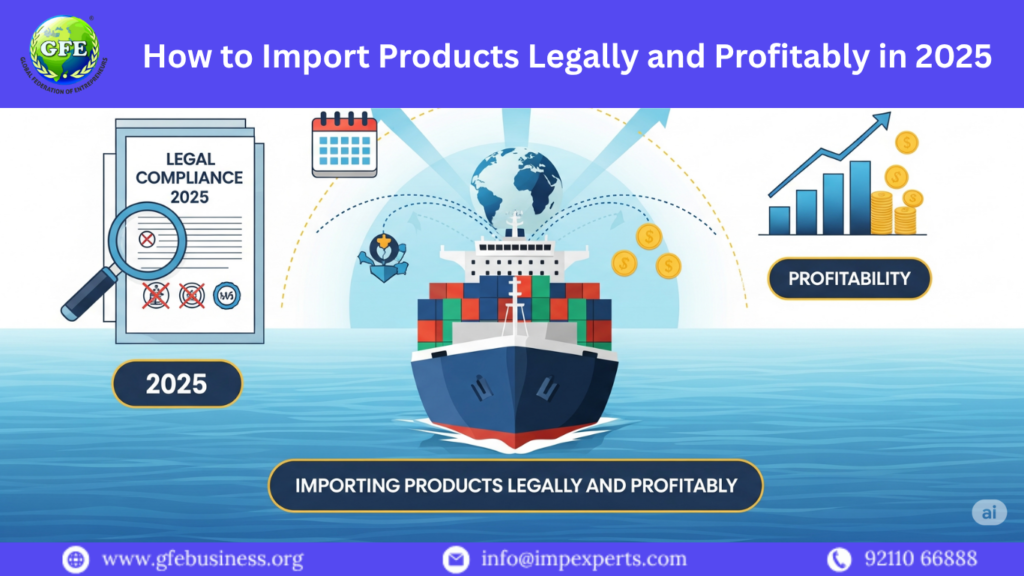Importing products into India is no longer restricted to big businesses. In 2025, traders, startups, and even individuals are legally importing goods and reselling them profitably — thanks to digital sourcing, simplified government regulations, and affordable shipping solutions.
Whether you want to import electronics, tools, garments, packaging items, or raw materials, it’s possible to build a successful business around it. The key is doing it legally, strategically, and with proper documentation.
At GFE Business, we train beginners and business owners in both import and export procedures. In this blog, we’ll walk you through the exact steps to import products into India in a legal and profitable way.
Why Importing Products Is a Growing Opportunity in India
India’s retail, e-commerce, and manufacturing sectors heavily depend on imported goods. From mobile accessories to industrial tools and food ingredients — imports fill major market gaps.
Here’s why importing is a smart business model in 2025:
High-demand products like gadgets, toys, kitchen tools, fashion items, and machinery are still more affordable from global markets.
Freight and courier options are now accessible for small and medium shipments.
B2B sourcing platforms make it easy to find suppliers without traveling abroad.
Digital payments, tracking, and government schemes support small importers more than ever.
But before you place your first order, you must understand the legal process.
Step 1: Register Your Business for Importing
To import products into India legally, you must be registered. The basic requirements include:
Firm Registration
You can start as a sole proprietorship, partnership, LLP, or private limited company.GST Registration
Required to legally bill and claim input tax credit.Import Export Code (IEC)
Issued by DGFT (Directorate General of Foreign Trade), this is a mandatory license for importers.Bank Account + AD Code
A current account is required to send foreign payments. Some imports may also require AD code registration with Customs.
These steps are not complex. At GFE Business, we assist entrepreneurs across India with documentation, registration, and compliance setup.
Step 2: Identify the Right Products to Import
Not every foreign product is profitable in India. You must import items with:
High resale margin
Verified Indian market demand
Reasonable shipping cost
Legal clearance from Indian customs
Examples of commonly imported products in 2025 include:
Small electronics (chargers, headphones, wearables)
Packaging materials and tools
Fashion jewelry and accessories
Bakery and kitchen tools
Components for assembly/manufacturing
Toys and learning kits for kids
Avoid banned or restricted goods and ensure your product has an appropriate HS Code (Harmonized System Code).
Step 3: Source Products from Reliable Global Suppliers
You don’t need to fly abroad to find suppliers. Here are the top ways to find legitimate import sources:
Alibaba, Made-in-China, 1688 (Use agents if required for language/locality)
Global Sources, DHgate, IndiaMart (for re-imported goods)
LinkedIn or Google Search for Factory Listings
Sourcing agents and inspection companies in China, Vietnam, UAE, etc.
Always ask for product samples, price breakdowns, MOQ (minimum order quantity), payment terms, and shipping options before placing your first order.
Also verify supplier documents, such as:
Business license
Export registration
Bank account details
Test certificates (for applicable goods)
Step 4: Understand Legal Import Process and Duties
Every imported product must pass through Indian Customs and may attract Basic Customs Duty (BCD), GST, Social Welfare Surcharge, and other applicable charges.
Here’s how the legal import process works:
You place an order and arrange payment via your current account.
The overseas supplier ships the goods to an Indian port or airport.
Shipping documents include Invoice, Packing List, and Bill of Lading or AWB.
Your CHA (Customs House Agent) files a Bill of Entry with Customs.
Duties are calculated and paid.
Your goods are cleared and delivered.
Always use a licensed CHA or freight forwarder to avoid mistakes or penalties. GFE Business connects importers with verified service providers to manage clearance smoothly.
Step 5: Resell Imported Goods Profitably
The real profit starts once your goods are cleared.
Here are four ways to resell imported items in India:
Wholesale Distribution: Supply to retail stores or e-commerce sellers.
E-Commerce Sales: List on Amazon, Flipkart, Meesho, or your own website.
Offline Retailing: Sell through shop counters or exhibitions.
B2B Supply: Sell to other manufacturers or resellers.
When pricing your product, include:
Product cost
Shipping charges
Import duties
Customs clearance cost
Marketing and packaging cost
Your expected margin (usually 30–100%)
You can even build a niche brand using imported products with your own labeling and packaging.
Step 6: Stay Compliant and Scale
To stay profitable and avoid legal issues, follow these best practices:
File regular GST returns
Keep all import documentation
Monitor HS Code updates and import restrictions
Build long-term relations with suppliers for better pricing
Join import-export training programs to stay ahead of competition
At GFE Business, we train importers across Gujarat, Maharashtra, West Bengal, and beyond on both legal process and business growth strategy.
Final Words
Importing products legally into India is not complicated when you follow the right process. With minimal investment, smart sourcing, and correct documentation, you can build a profitable importing business — even as a newcomer.
If you’re ready to import products the right way and earn globally, this is the best time to begin.
Visit 👉 www.gfebusiness.org and get expert help to launch your import journey in 2025 — legally and profitably.








